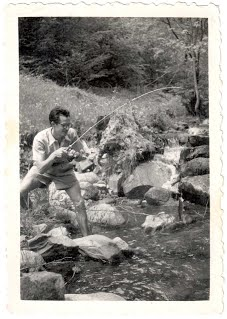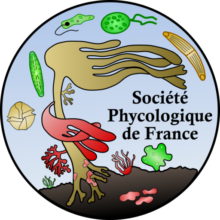
F. Magne successfully fishing a trout in a river in Alsace, around 1950.
Family collection.
Professor Francis Magne died on May 22, 2014 in Yerres (91) and was born on January 19, 1924 in Paris. He ended his professional career as a teacher/researcher in 1992, at the University P. & M. Curie, directing the laboratory of “Marine Plant Biology” (BVM), created by Professor Jean Feldmann. His parents were small businessmen. In spite of a family environment not oriented towards university studies, F. Magne presents an exemplary career having participated in the three levels of French education: primary, secondary, higher, during a particularly difficult historical period. After a successful schooling to become a primary school teacher (1943), he obtained his university degrees at the Sorbonne (1945) while being a day supervisor at the Lycée Turgot, where he rubbed shoulders with Marius Chadefaud who was to have a great importance in his scientific life. He then obtained a Diplôme d’Etudes Supérieures(1), required to take the agrégation exams. He was brilliantly successful (1948) in this competition, the royal road to teaching in high schools and, as a result, he was assigned as an associate professor at the Lycée de Colmar and then at the Lycée Lakanal in Sceaux. In October 1951, he began his career in higher education by being appointed as an assistant at the Sorbonne, PCB department(2) where J. Feldmann was already teaching. Thus, the latter may have had an influence on the orientation of F. Magne towards marine algae.
Very quickly his research was carried out at the Roscoff Biological Station. He was appointed assistant in October 1954 because the director at the time, Georges Teissier, although a zoologist, wanted to promote the development of studies on marine algae. Thus, F. Magne participated in the activities of the station by completing them with a botanical component while also assuming the functions of an efficient and rigorous manager! As early as 1956, he collaborated with J. Feldmann to launch the organization of specialized courses in marine plant biology. His personal research on algae led to a thesis that was highly regarded both nationally and internationally(3). In October 1965, he was appointed to the Faculty of Sciences of Rennes-Beaulieu and then, in October 1971, to the University of Paris VI-Jussieu, which became “Université P. & M. Curie”. Within the latter, he is responsible for the coordination of the certificate n°1 of botany, while continuing his research in premises close to those that Professor Chadefaud continued to frequent assiduously. In 1976, F. Magne succeeded J. Feldmann and took over the direction of the “BVM” laboratory. He remained at its head until 1992, date of his own retirement, having, alas, the sad privilege of closing this center, which for more than 40 years had been recognized worldwide for having revived and renewed phycology in France. With the help of Professor Alain Couté, then director of the “Laboratoire de Cryptogamie”, Francis Magne continued his research at the Muséum National d’Histoire Naturelle, but his strength gradually weakened.
Regarding his scientific activities, in addition to his worldwide reputation as a researcher in phycology, F. Magne must be considered as a pioneer in two particular fields: lichenizing fungi on the one hand and underwater diving on the other. For his Diplôme d’Etudes Supérieures (DES), published in 1947(4), he was the first to analyze the apical complex of asci in certain lichens, thus extending the research undertaken by M. Chadefaud, on the structure and functioning of the apical system of dehiscence of asci in ascomycetes fungi. Later, this research theme was developed by many researchers in lichenology. From August 25 to October 6, 1952, he participated in the campaign of the “Calypso” at the “Grand Congloué” located at about ten kilometers from Marseille. His observations, obtained by scuba diving with the help of the “Gagnan-Cousteau” scuba suit, were published in 1956(5). He was one of the first phycologists in France to follow the example of P. Drach, a zoologist, to observe marine populations in situ. However, while Julius Ernst in the Channel and Roger Molinier in the Mediterranean, followed by many others, developed and generalized this technique, it should be noted that F. Magne no longer practiced it and devoted himself to other research themes on algae. By the importance of the scientific results obtained, F. Magne remains a world-renowned researcher. From long, meticulous, often difficult observations, followed by rigorous personal reflections, he reached conclusions that revolutionized the concepts classically accepted before him. This was particularly remarkable with respect to our knowledge of the life cycles of red algae. His paper presented at the 4th International Seaweed Symposium (18/24 September 1961 in Biarritz, France) is an emblematic example(6). Indeed, in front of this community of phycologists, he demonstrates that from “chromosomal counts practiced in a certain number of Rhodophyceae with a supposed haplophasic cycle…meiosis did not take place as the classical opinion wants immediately after fertilization. [Consequently] these algae can only have a haplo-diplophase cycle and most likely a trigenetic morphological cycle.” Thus the teaching of phycology was turned upside down. These observations led to research on the life cycles of algae for more than a quarter of a century, starting with a synthesis by F. Magne himself(7) of a great pedagogical quality with very explicit original diagrams particularly useful for teachers. An overview of the main themes that F. Magne explored is given by Professor Michael Wynne to accompany the publications dedicated to F. Magne, on the occasion of his 75th birthday(8). His career, presented in English, is being published in Cryptogamie-Algologie (R. Delépine & L. Le Gall). A complete list of his publications is in progress at the Museum National d’Histoire Naturelle (D. Lamy & L. Le Gall).
Several taxa have been dedicated to F. Magne by other researchers, as a token of esteem and recognition, such as: Rhodosorus magnei Fresnel & Billard ; Dasya magnei Ballantine ; Veleroa magneana A. J. K. Millar. He has, himself or in collaboration, described new taxa or participated in the updating of their nomenclature, such as: Apistonema aestuari Magne; Audouinella boryana Abdel-Rahman & Magne ; Fucus muscoides (A. D. Cotton) Feldmann & Magne alias Fucus cottonii Wynne & Magne.
His teaching skills were always appreciated. Thanks to a clear mind and real pedagogical qualities, with a beautiful ease to illustrate his talks, he marked many generations of students. He handled the French language with great confidence, always looking for the right word, and thus had a very recognizable diction. Everything he undertook was thought out and completed in the best possible way. He was a genius tinkerer and had a passion for things well done, as his many practical accomplishments demonstrate, whether it was his truck which he converted into a “camper” so useful for phycological surveys or … sharing some “gourmet” picnics with other friends, the organization and instrumental setups in his work stall or those given as gifts to colleagues, or his interest and success in the maintenance of a large garden and of plant nature in general. His passion for fishing – and his thorough knowledge of the trout rivers in Brittany – is well known as well as his taste – and his proven skills – for cooking, which he loved to share; he also had an excellent address book of good places to eat. In daily life, he showed the same qualities of rigor and thoroughness, which often led him to defend his ideas with great tenacity. His human generosity also manifested itself in his investment, through the Secours Catholique, in helping the most disadvantaged. These human aspects of his personality made him appreciated by many: colleagues, students, collaborators, and even his neighbors, as shown by his relations with Chadefaud who wrote (letter of September 26, 1961, to A. Parguey) “[at the 4th congress of algology in Biarritz] a really important communication was that of F. Magne(9) who dares to speak in public and does so in such a learned tone, with such authority, that one cannot doubt that this boy will soon be in the Academy. In any case his work is remarkable, by the horizons it opens on the evolution of algae at the level of the Rhodophyceae” appreciation that should be put in parallel with the thanks that F. Magne expresses as much in the dissertation of his DES “[Chadefaud] who has always been a critic and a guide never short of advice or encouragement” as in that of his thesis “[Chadefaud] who has never ceased, since my years spent at the Lycée(10) to honor me with his kind friendship. He guided my first steps in the field of botany and plant cytology; I owe my commitment to my scientific career to him, and without his example, advice, and encouragement, this dissertation … would probably not have seen the light of day.”
I met F. Magne during the summer of 1956, as one of the twelve participants in the first field course in marine plant biology, organized in Roscoff by J. Feldmann and him. This training course determined my scientific orientation as well as the choice of the subject of my DES on the Codium of the coasts of France. I do not forget, either, the empathy that he showed me during the painful death of my mother.
I owe valuable information to the family of Francis Magne, to the archives of the university and educational institutions, and to many colleagues. I thank them all very warmly for their help and everyone will be able to recognize their contribution to the text of this memorial note.
René Delépine – August 2014
(1)His research for the Diplôme d’Etudes Supérieures, “patronized” by G. Mangenot, professor at the Sorbonne, was carried out under the supervision of M. Chadefaud at the National Museum of Natural History.
(2)The PCB [certificat d’études Physique, Chimie, Biologie] was a certificate prepared in the faculties of sciences and whose possession was necessary to undertake studies in the faculties and schools of medicine. Created in 1934, it will evolve in 1963 towards the CPEM (preparatory certificate for medical studies) then towards the PCEM (first cycle of medical studies) in 1969
(3)Magne F. 1964. Karyological investigations in the Floridae (Rhodophyceae). Cahiers de Biologie marine. 5: 461-671 ; planches I à XVII
(4)Magne F. 1947. Anatomy and morphology of the asci of some lichens.Rev. Bryol. Lichen. 15: 203-209
(5)Magne F. 1956. The marine vegetation of Grand Gongloué. Scientific results of the “Calypso” campaigns fasc. 2; Annales Institut Océanographique. 32: 163-184
(6)Magne F. 1964. LDo Rhodophyceae with haplophasic cycle exist? Proceedings 4th International seaweed Symposium p112-116
(7)Magne F. 1972. Le cycle de développement des Rhodophycées et son évolution. Bulletin société. Botanique France, Mémoires p 247-268
(8)Wynne M. J. 2000. Francis Magne: a tribute. Cryptogamie Algologie. 21: 93-95
(9)M. Chadefaud rightly refers to this famous communication entitled “Do Rhodophyceae with haplobiont cycle exist?” mentioned above. For my part, it has often served to illustrate a rigorous method of scientific reasoning based on very precise proven observations instead of relying on an a priori apparently “logical” scheme.
(10)This formulation suggests that M. Chadefaud, who was then a professor of natural sciences at the Collège Turgot since 1929, may have already known F. Magne as a student during his undergraduate studies. This is plausible since F. Magne is of age to have completed his classes from the 6th to the 3rd grade in the period 1934 to 1940. Unfortunately, all the researches made to confirm this possibility were in vain.
